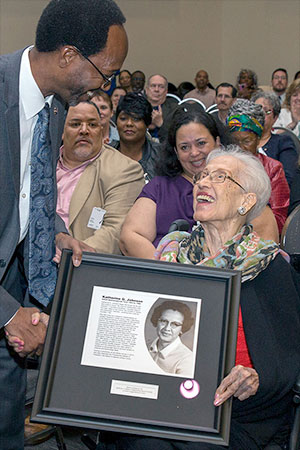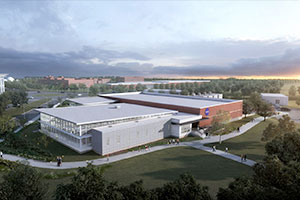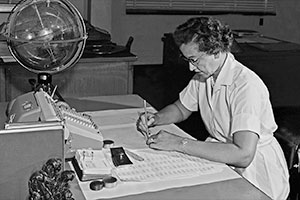May 5, 2016 — Fifty-five years after she helped compute, by hand, the trajectory for the first American astronaut into space, NASA honored mathematician Katherine Johnson with the dedication of a new building at the research center where she worked.
"Millions of people from around the world watched [Alan] Shepard's flight but what they don't know — what they did not know at the time, was that the calculations that got him into space and safely home were done by today's guest of honor," said Clayton Turner, the deputy director of Langley Research Center in Hampton, Virginia, during a dedication ceremony held on Thursday (May 5).
A trailblazer for women and African Americans in the early U.S. space program, Johnson's name will grace Langley's new Computational Research Facility.
"The facility will be a 40,000-square-foot consolidated data center that will allow engineers and scientists to perform advanced computational research and development," said Turner, "crunching data and numbers that will one day help NASA land humans on Mars; design quieter, faster and more efficient future aircraft; and help us better understand our changing climate. It's not unlike the work Katherine did in her tenure, helping NASA send the first Americans into space, into orbit around Earth and to the moon and back — except she didn't have a 40,000 square foot building full of cutting edge technology."
When Johnson began work at Langley in 1953, she was among a pool of African-American women whose role it was to be the "computers." Hired by the National Advisory Committee for Aeronautics, the predecessor to NASA, she and her colleagues performed the mathematical equations and calculations needed by the engineers to advance their aeronautical work.
"Thank you so much for your attention and your kindness, but more than that I am so happy that you are now giving more recognition to women for the work they have done," Johnson, 97, said. "I thank you for recognizing that women have long been doing a lot of the work."
As a computer for NASA, Johnson calculated the trajectory for Alan Shepard, who became the first American to fly into space on May 5, 1961. Even after the agency began using electronic computers, astronaut John Glenn requested that she re-check the machine calculations before he launched to become first American to orbit the Earth in 1962.
Johnson continued to work at NASA until 1986, combining her talent for mathematics with electronic computer skills. Her trajectory calculations proved as critical to the success of the Apollo moon landings and start of the space shuttle program, as they were for those early steps on the United States' journey into space.
"Mrs. Johnson set a proud example for people to follow their dreams, no matter the norms and conventions, and to reach for the stars in their own lives," stated Senator Tim Kaine (D-VA) in a video statement. "Mrs. Johnson may not have flown to the moon herself, but she is an example of how to shoot for the moon."
The Computational Research Facility's naming is the latest honor for Johnson, who in 2015 was awarded the nation's highest civilian award, the Presidential Medal of Freedom. NASA also earlier recognized Johnson for her work on the five Lunar Orbiter spacecraft that orbited and mapped the moon in preparation for the Apollo program.
In addition to the building dedication on Thursday, Johnson was also presented the Silver Snoopy pin, the astronauts' own award for recognizing outstanding performance while contributing to flight safety and mission success.
"Those of us comprising NASA flight crews, especially the early heroes of spaceflight, Shepard, Glenn, and the crews of Apollo 11 and the maiden voyage of the space shuttle Columbia, recognize that the success of each mission is measured by the dedication to excellence and teamwork of such people like Katherine. Her efforts demonstrated that she was a vital link in the success of our space programs," said Leland Melvin, a former Langley employee and NASA astronaut.
Johnson, along with her fellow human computers, will soon be the focus of "Hidden Figures," an upcoming feature film based on a book of the same title by Margot Lee Shetterly. Taraji P. Henson ("Cookie" on the television drama series "Empire") portrays Johnson. The movie also stars Octavia Spencer, Janelle Monáe, Kevin Costner and Jim Parsons. |
|

Mathematician Katherine Johnson receives a replica of the plaque dedicating the Computational Research Facility at NASA's Langley Research Center in her honor, May 5, 2016. (NASA/Langley)

Artist's rendering of the 40,000-square-foot Katherine G. Johnson Computational Research Facility at the Langley Research Center in Hampton, Virginia. (NASA)

Mathematician Katherine Johnson at work as a "human computer" at the Langley Research Center in Hampton, Virginia. (NASA) |
